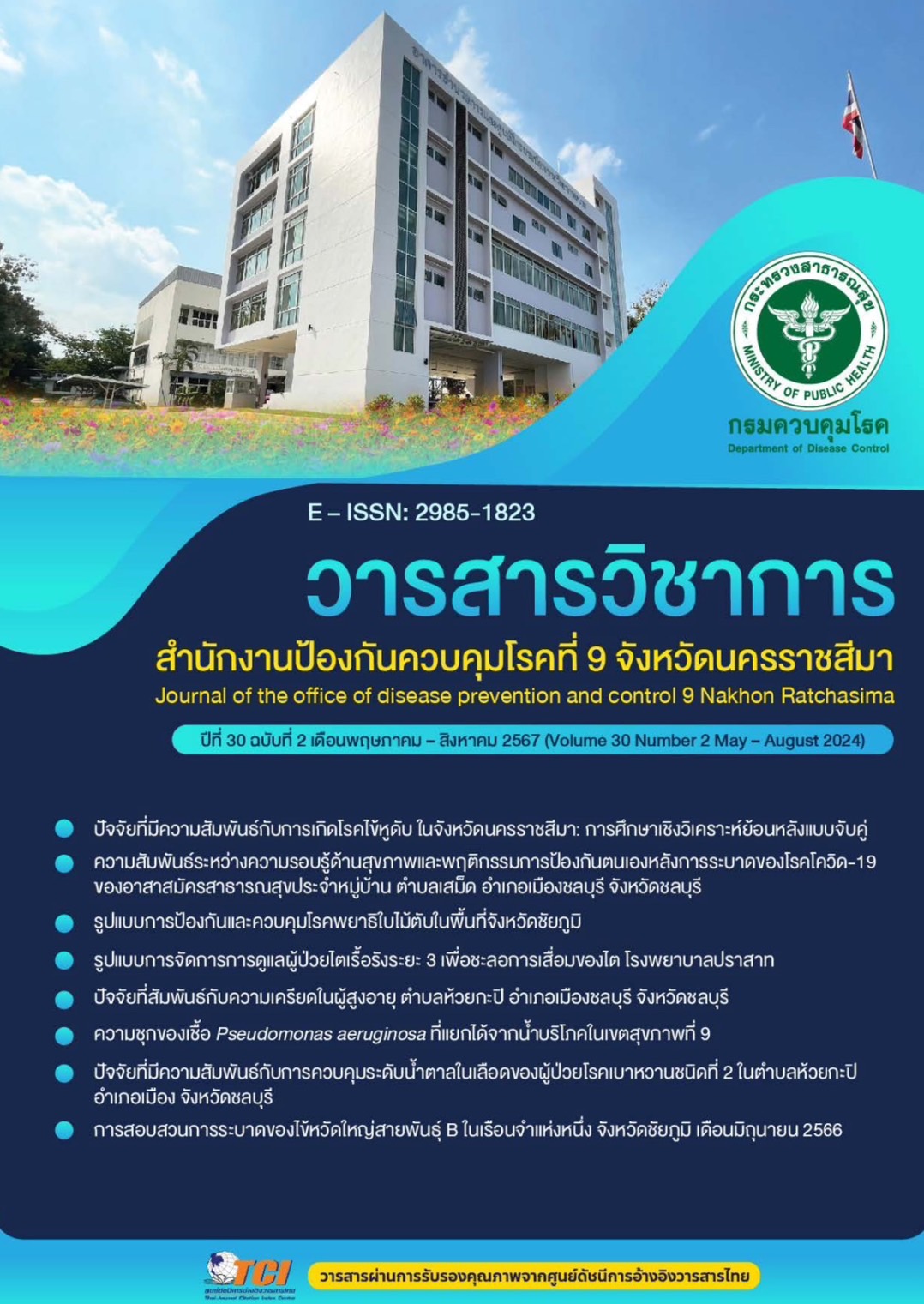Prevalence of Pseudomonas aeruginosa Isolates in Drinking Water from Health Region 9
Keywords:
Pseudomonas aeruginosa, Drinking Water, Antibiotic resistanceAbstract
The study aimed to investigate the prevalence and evaluate the microbiological quality of drinking water through the analysis of Coliform bacteria, Escherichia coli, Salmonella spp., Staphylococcus aureus, and Pseudomonas aeruginosa in samples sourced from producers of bottled and containerized drinking water. A total of 241 samples were collected in Health Region 9 between January and May 2022. Microbiological analyses were performed using standard procedures specified by the American Public Health Association (APHA) and the International Organization for Standardization (ISO) at the Regional Medical Sciences Center 9, Nakhon Ratchasima. The results of the microbiological quality revealed that the water did not pass the standard criteria level, as Coliform bacteria were detected at 13.28%, and E. coli was present at 1.66%. These findings indicated microbial contamination and inadequate production standards. P. aeruginosa was detected at 19.50%, showing a significant statistical association with Coliforms bacteria contamination (p <0.0001). Sensitivity testing of 28 P. aeruginosa isolates using Disc Agar Diffusion for 12 antibiotics showed that 22 isolates were sensitive to amikacin, gentamicin, tobramycin, cefepime, ceftazidime, ciprofloxacin, levofloxacin, piperacillin, piperacillin/tazobactam, imipenem, meropenem, and colistin. Three isolates exhibited intermediate resistance to ceftazidime and cefepime, with two isolates being resistant to cefepime only, and one isolate resistant to ceftazidime only. MIC testing was conducted on isolates that exhibited either susceptibility or intermediate resistance to antibiotics. The results revealed that all five isolates were susceptible to amikacin, gentamicin, cefepime, ciprofloxacin, piperacillin/tazobactam, meropenem, and colistin. Additionally, the isolates showed resistance to imipenem. Moreover, MIC and MBC testing against extracts of Syzygium aromaticum showed values of 2.56 mg/mL, while Stephania suberosa demonstrated respective values of 5.12 mg/mL and 10.24 mg/mL. This study provides insights into antibiotic resistance in drinking water, contributing to the monitoring and control of contamination risks. Furthermore, the utilization of plant extracts, particularly from cloves (S. aromaticum), demonstrated significant inhibitory effects on P. aeruginosa, suggesting their potential use in combination with antibiotics to reduce antibiotic consumption in the future.
References
พรรณนิกา ฤตวิรุฬห์. แบคทีเรียดื้อยา. พิมพ์ครั้งที่ 1. พิษณุโลก: สำนักพิมพ์มหาวิทยาลัยนเรศวร; 2563.
Calero Preciado C, Boxall J, Soria-Carrasco V, Martínez S, Douterelo I. Implications of Climate Change: How Does Increased Water Temperature Influence Biofilm and Water Quality of Chlorinated Drinking Water Distribution Systems? Front Microbiol. 2021;12:658927.
กรุณา ตีรสมิทธ์, ปิยมาศ แจ่มศรี, บัณฑูร พานิชกุล, อภิชาติ แก้วชื่นชัย, หนึ่งฤทัย กาญจนพันธ์. การปนเปื้อนเชื้อ Pseudomonas aeruginosa ในน้ำแร่บรรจุขวด น้ำบริโภคบรรจุขวด น้ำจากตู้หยอดเหรียญ และน้ำจากตู้กดน้ำเย็น. วารสารอาหารและยา. 2564;28(2):66-75.
ชุตินันท์ คงสรินทร์. ฤทธิ์การยับยั้งของสารสกัดสมุนไพรต่อเชื้อ Pseudomonas aeruginosa ที่คัดแยกจากน้ำดื่มบรรจุขวด [วิทยานิพนธ์ปริญญาวิทยาศาสตรมหาบัณฑิต]. กรุงเทพฯ: มหาวิทยาลัยเกษตรศาสตร์; 2557.
กระทรวงสาธารณสุข. ประกาศกระทรวงสาธารณสุข (ฉบับที่ 61) พ.ศ.2524 เรื่องน้ำบริโภคในภาชนะบรรจุที่ปิดสนิท. ราชกิจจานุเบกษา ฉบับที่ 98, ตอนที่ 157 (ลงวันที่ 24 กันยายน 2524).
กระทรวงสาธารณสุข. ประกาศกระทรวงสาธารณสุข (ฉบับที่ 416) พ.ศ.2563 เรื่องกำหนดคุณภาพหรือมาตรฐาน หลักเกณฑ์เงื่อนไข และวิธีการในการตรวจวิเคราะห์ ของอาหารด้านจุลินทรีย์ที่ทำให้เกิดโรค. ราชกิจจานุเบกษา เล่มที่ 137, ตอนพิเศษ 237 ง (ลงวันที่ 2 กันยายน 2563).
กระทรวงสาธารณสุข. ประกาศกระทรวงสาธารณสุข (ฉบับที่ 199) พ.ศ. 2543 เรื่องน้ำแร่ธรรมชาติ. ราชกิจจานุเบกษา ฉบับประกาศทั่วไป เล่มที่ 118, ตอนพิเศษ 6 ง (ลงวันที่ 24 มกราคม 2544).
Performance standards for antimicrobial susceptibility testing. CLSI supplement M100. 30th ed. Wayne: Clinical and Laboratory Standards Institute; 2020.
American Public Health Association, American Water Works Association, Water Environment Federation. Standard methods for the Examination of water and wastewater. 23rd ed. Washington DC: American Public Health Association; 2017.
International Organization for Standardization. Water quality Detection and enumeration of Pseudomonas aeruginosa Method by membrane filtration [Internet]. 2006 [cited 2022 April 26]. Available from: https://www.iso.org/standard/39272.html.
International Organization for Standardization. Water quality - detection of Salmonella spp. [Internet]. 2010 [cited 2022 April 26]. Available from: https://www.iso.org/standard/43448.html.
Tarazi YH, Abu-Basha E, Ismail ZB, Al-Jawasreh SI. Antimicrobial susceptibility of multidrug-resistant Pseudomonas aeruginosa isolated from drinking water and hospitalized patients in Jordan. Acta Trop. 2021;217:105859.
Hamad AA, Sharaf M, Hamza MA, Selim S, Hetta HF, El-Kazzaz W. Investigation of the Bacterial Contamination and Antibiotic Susceptibility Profile of Bacteria Isolated from Bottled Drinking Water. Microbiol Spectr. 2022;10(1):e0151621.
Ghorbani G, Rahimi E, Shakerian A. Antibiotic resistance's Genotypic and Phenotypic Characteristics and the Frequency of Virulence Factors in P. aeruginosa Isolates Isolated from Water Samples in Iran. Biomed Res Int. 2022;2022:7076433.
Al-Mijalli SH, El Hachlafi N, Abdallah EM, Jeddi M, Assaggaf H, Qasem A, et al. Exploring the antibacterial mechanisms of chemically characterized essential oils from leaves and buds of Syzygium aromaticum (L.) Merr. et Perry against Staphylococcus aureus and Pseudomonas aeruginosa. Industrial Crops and Products. 2023;205:117561.

Downloads
Published
How to Cite
Issue
Section
License
Copyright (c) 2024 The office of disease prevention and control 9th Nakhon Ratchasima

This work is licensed under a Creative Commons Attribution-NonCommercial-NoDerivatives 4.0 International License.
บทความที่ลงพิมพ์ในวารสารวิชาการสำนักงานป้องกันควบคุมโรคที่ 9 จังหวัดนครราชสีมา ถือว่าเป็น
ลิขสิทธิ์ สำนักงานป้องกันควบคุมโรคที่ 9 จังหวัดนครราชสีมา



